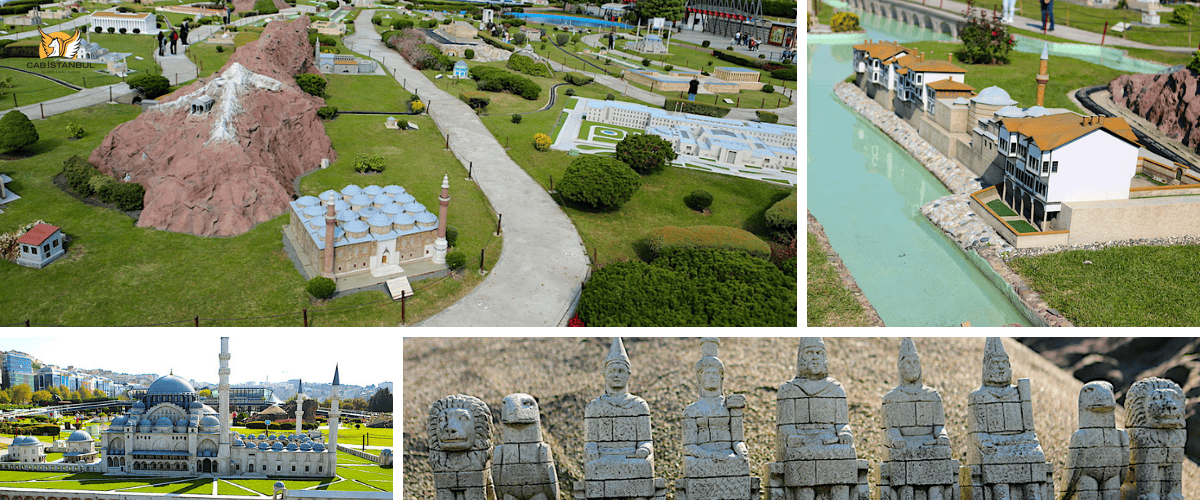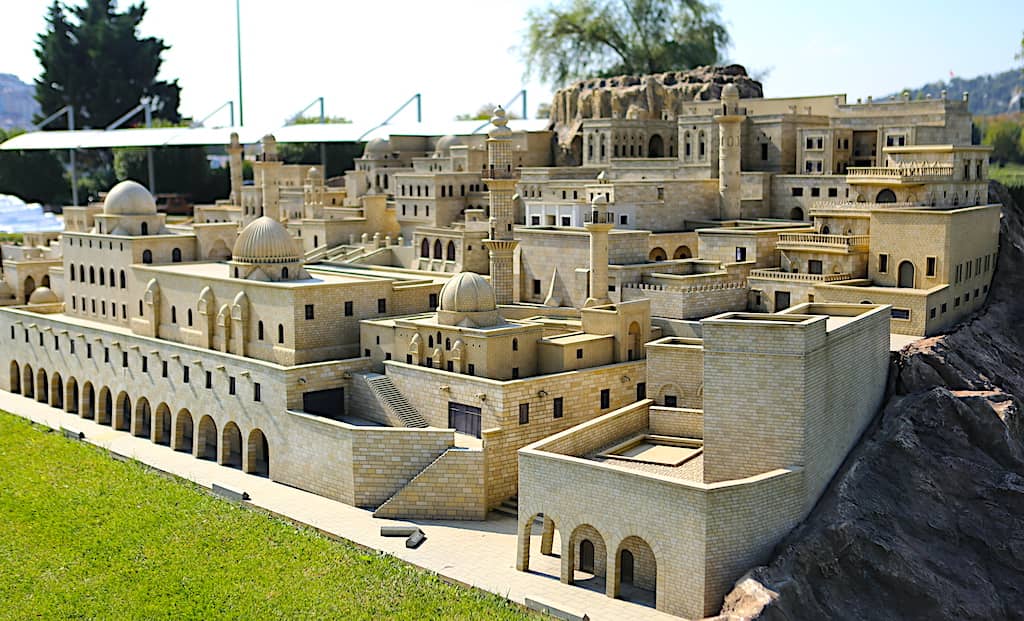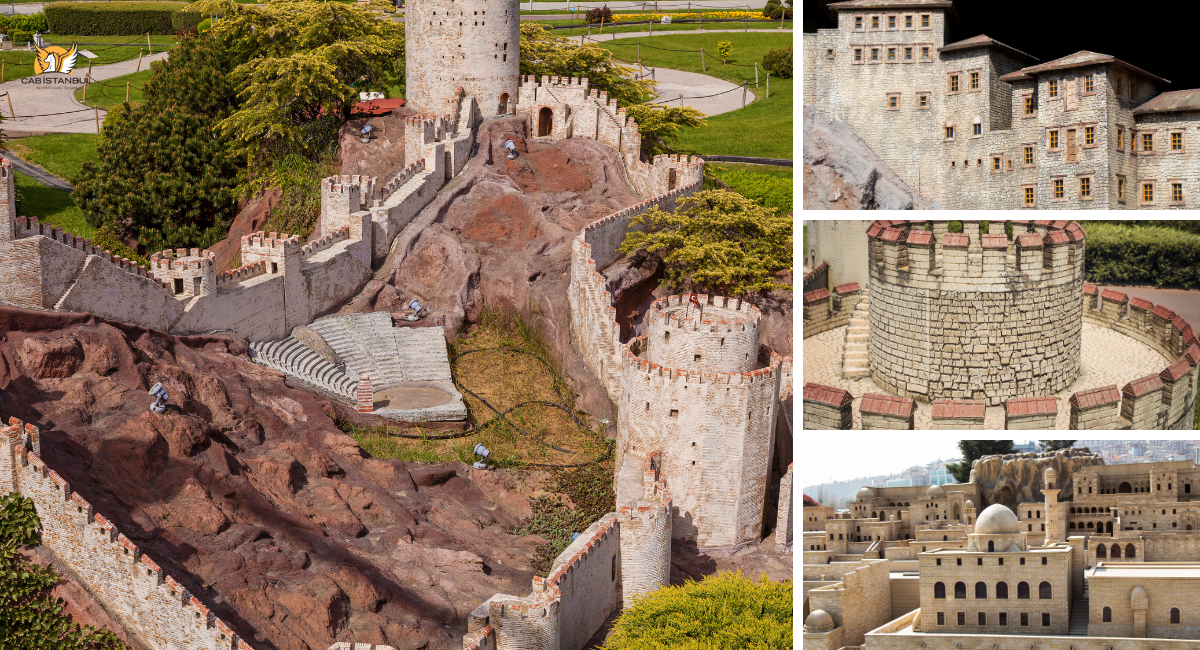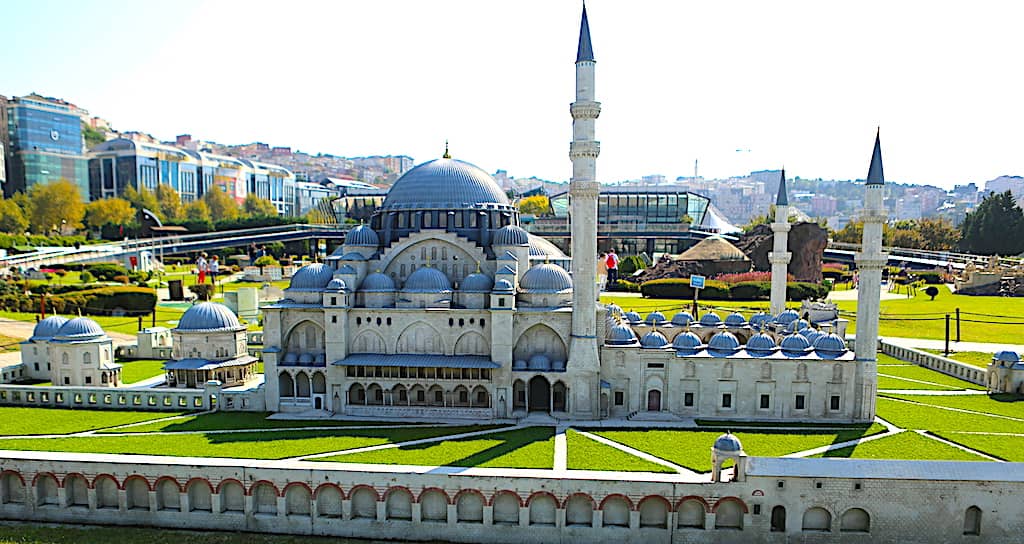Miniatur Park Istanbul
2025-12-13

Miniaturk Istanbul
Miniaturk istanbul is one of the world’s largest miniature parks and a must-visit destination for history and culture enthusiasts, located on the banks of the Golden Horn in Istanbul. With over 130 detailed models, miniaturk showcases iconic landmarks from across Turkey and the former Ottoman Empire in 1/25 scale, allowing visitors to explore centuries of architecture and heritage in just a few hours.
Covering an area of 60,000 square meters, miniaturk includes 15,000 square meters of exhibition space, filled with meticulously crafted replicas of sites such as Hagia Sophia, Topkapi Palace, the Bosphorus Bridge, Cappadocia, and the ancient city of Ephesus. The open-air museum offers an engaging journey through Turkish history, blending culture and education with entertainment.
What makes miniaturk istanbul even more appealing is its interactive features: a sightseeing train, a fairy tale tree, remote-controlled boats, a helicopter simulation ride, and play zones for children. Multilingual audio guides are available in nine languages including English, Arabic, French, German, and Spanish, enhancing the experience for international tourists. İts in Sutluce, near Eyup, miniaturk is easily accessible from Istanbul’s city center by bus, taxi, or private vehicle. Its proximity to other popular sites such as the Rahmi Koc Museum, Pierre Loti Hill, and Eyup Sultan Mosque makes it a perfect starting point for cultural exploration. Whether you're a family with kids, a solo traveler, or part of a tour group, miniaturk istanbul offers an unforgettable and compact overview of Turkey’s historical and architectural richness.
Discover Miniaturk and Istanbul’s top attractions with ease by booking our airport transfer or car with driver service. Enjoy professional drivers, safe vehicles, and a stress-free journey tailored for solo travelers or groups with Cab Istanbul.
Miniaturk Park
Iconic Structures of Istanbul at Miniaturk
Miniaturk Istanbul presents a stunning collection of historic landmarks that reflect the grandeur, faith, and imperial legacy of the city once known as Constantinople. Below is a selection of iconic structures faithfully recreated in miniature, each telling a unique story from the heart of Istanbul’s architectural heritage-
Hagia Sophia: A masterpiece of Byzantine architecture, this legendary structure served as both a church and a mosque for centuries.
Topkapi Palace: The imperial residence of Ottoman sultans and a symbol of dynastic power.
Blue Mosque (Sultanahmet Mosque): Famous for its elegant domes and striking blue tiles.
Suleymaniye Mosque: Designed by the great architect Mimar Sinan, this mosque is a pinnacle of Ottoman aesthetics.
Galata Tower: A medieval stone tower that has watched over Istanbul for centuries.
Maiden’s Tower: A romantic symbol in the Bosphorus, wrapped in mystery and legends.
Dolmabahce Palace: A lavish waterfront palace reflecting the opulence of the late Ottoman period.
Rumeli Fortress: Commissioned by Sultan Mehmed the Conqueror before the siege of Constantinople.
Bosphorus Bridge: The first bridge to unite Europe and Asia, recreated at a walkable scale in miniaturk istanbul.
Fatih Sultan Mehmet Bridge: A modern engineering marvel and a vital part of the city’s identity.
Taksim Republic Monument: Celebrating the foundation of the Turkish Republic.
Haydarpasa Train Station: An architectural gem once connecting Anatolia to Europe.
Basilica Cistern: A hauntingly beautiful Byzantine-era underground water reservoir.
Column of Constantine (Cemberlitas): A Roman monument marking the city’s ancient past.
Beyazit Tower: Once a fire-watch tower, now a silent witness over the city’s rooftops.
Valens Aqueduct: A Roman aqueduct that once carried water across the growing city.
Yildiz Palace: A late Ottoman complex surrounded by serene gardens.
Sirkeci Station: The final stop of the fabled Orient Express.
Ciragan Palace: A refined example of Ottoman waterfront architecture, now a luxury hotel.
Ecumenical Patriarchate of Constantinople: A sacred center for Orthodox Christianity.
Hagia Irene: One of the oldest churches in Istanbul, located within the Topkapi Palace complex.
Grand Bazaar: A bustling historical market, the heart of Ottoman commerce.
New Mosque (Yeni Camii): An Ottoman mosque standing prominently near the Golden Horn.
Beylerbeyi Palace: Nestled on the Asian side of the Bosphorus with royal charm.
Valide Sultan Mosque: A historic mosque adorning the skyline of Uskudar.
Anatolian Fortress: Built before the conquest, guarding the narrowest point of the Bosphorus.
Hirka-i Serif Mosque: The resting place of the Prophet Muhammad’s sacred cloak.
Kucuksu Pavilion: An elegant Ottoman hunting lodge by the water.
Sultanahmet Prison (now Four Seasons Hotel): A former prison transformed into a luxurious retreat.
Sogukcesme Street: A charming alley lined with restored Ottoman houses.
Golden Horn Shipyard: One of the oldest continuously operating shipyards in the world.
Ottoman Legacy Out of Turkey in Miniaturk
Mostar Bridge: A masterpiece of Ottoman engineering in Bosnia and Herzegovina, rebuilt as a symbol of unity and resilience.
Selimiye Mosque (Cyprus): A prominent example of Ottoman religious architecture in Nicosia, originally a Gothic cathedral later transformed into a mosque.
Ecyad Fortress: Once overlooking Mecca, this Ottoman-built stronghold protected the holy city before its controversial demolition in the early 21st century.
Suleymaniye Mosque (Rhodes): Located on the island of Rhodes, this elegant mosque reflects the island’s Ottoman past through intricate design and domed elegance.
Al-Aqsa Mosque: Situated in Jerusalem, it is one of the holiest sites in Islam and was maintained and expanded during Ottoman rule. Its inclusion in miniaturk istanbul underscores its religious and cultural importance.
Hejaz Railway Station: Built as part of the Hejaz Railway Project, this station in the Arabian Peninsula once connected Damascus to Medina, reflecting the Ottomans’ infrastructural ambitions across the Islamic world.
Treasures of Anatolia at Miniaturk Istanbul
The heart of miniaturk istanbul beats with the legacy of Anatolia — the cradle of civilizations and crossroads of empires. This remarkable open-air museum brings together some of the most iconic architectural and historical wonders from every corner of the Turkish mainland, presented with exquisite detail in miniature form.
Mausoleum at Halicarnassus: Once located in Bodrum, this monumental tomb was one of the Seven Wonders of the Ancient World, blending Greek and Anatolian traditions.
Temple of Artemis: Situated in Ephesus, near Izmir, this ancient Greek sanctuary was also part of the Seven Wonders, and is now remembered for its grand columns and mythological significance.
Anitkabir: The monumental mausoleum of Mustafa Kemal Ataturk in Ankara, a powerful symbol of Turkish independence.
Selimiye Mosque: A brilliant creation by Mimar Sinan in Edirne, considered the pinnacle of Ottoman mosque architecture.
Pamukkale Travertines: A surreal landscape of white calcium terraces in Denizli, shaped by nature over millennia.
Mount Nemrut: Towering statues of ancient gods in Adiyaman, a UNESCO-listed site from the Kingdom of Commagene.
Sumela Monastery: A cliffside Orthodox monastery in Trabzon, offering spiritual mystique and historical depth.
Aspendos Theater: One of the best-preserved Roman amphitheaters in the world, located in Antalya.
Mevlana Mausoleum: The resting place of Rumi, the 13th-century Sufi poet, in Konya.
Safranbolu Houses: Exemplary Ottoman-era homes that reflect the elegance of traditional Turkish urban planning.
Cappadocia Fairy Chimneys: Fantastical volcanic rock formations of Nevsehir, now a symbol of Anatolian mysticism.
Canakkale Martyrs' Memorial: Honoring the soldiers who fought in the Gallipoli Campaign during World War I.
Divrigi Grand Mosque and Hospital: A masterpiece of Seljuk art in Sivas, on the UNESCO World Heritage list.
Ishak Pasha Palace: A hybrid Ottoman-Seljuk fortress-palace in the rugged terrain of Agri.
Ephesus (Celsus Library): The grandeur of Roman-era architecture lives on in Izmir’s archaeological jewel.
Diyarbakir Grand Mosque: One of the oldest mosques in Anatolia, reflecting layers of religious heritage.
Mardin Stone Houses: Distinctive masonry homes overlooking the Mesopotamian plains.
Zeugma Mosaic Museum: A tribute to Gaziantep’s ancient Roman artistry.
Amasya Riverside Mansions: Ottoman-era homes along the banks of the Yesilirmak River.
Hattusa (Lion Gate): The ceremonial entrance to the Hittite capital in Corum.
Alanya Castle: A coastal stronghold built during the Seljuk period in Antalya.
Ince Minaret Medrese: A refined example of Seljuk stone craftsmanship in Konya.
Bursa Grand Mosque: A cornerstone of early Ottoman mosque design.
Green Tomb: The resting place of Sultan Mehmet I, famous for its turquoise tiles in Bursa.
Yivli Minaret: A fluted minaret that stands as a Seljuk symbol of Antalya.
Ani Ruins: Medieval Armenian churches and mosques in Kars, evoking the forgotten grandeur of a lost city.
Pigeon Island Castle (Kusadasi): A coastal fortress once guarding the Aegean.
Trabzon Hagia Sophia: A Byzantine church later converted into a mosque, representing religious transition.
Adana Stone Bridge (Taskopru): A Roman bridge still in active use after 2,000 years.
Balikligol (Sanliurfa): A sacred pool believed to be the birthplace of Prophet Abraham.
Van Grand Mosque: A rarely seen Seljuk treasure in eastern Anatolia.
Double Minaret Madrasa (Erzurum): One of the most majestic Seljuk monuments in Turkey.
Kutahya Tile Museum (Gok Medrese): A showcase of Ottoman tile art and ceramic heritage.
Amasra Castle: A dual legacy of Genoese and Ottoman rule on the Black Sea coast.
Tokat Gok Medrese: A Seljuk educational center with decorative blue tilework.
Nasrullah Mosque (Kastamonu): A prime example of civic-centered Ottoman mosque architecture.
Siirt Grand Mosque: Modest in scale, yet profound in spiritual significance and Seljuk form.
Miniature Mardin Stone Houses

Miniaturk
The Miniaturk stands as a monumental tribute to the diverse architectural splendor that has been bestowed upon this land by various civilizations, spanning from the ancient eras, through the Roman and Byzantine Empires, to the Seljuk and Ottoman periods. Inaugurated in 2003 by the Istanbul Municipality, the museum ambitiously encapsulates Turkey’s rich heritage, proudly presenting itself under the banner "A Small Model of a Great Nation.
Miniaturk's Extensive Collection
The museum proudly displays an extensive collection of 268 miniature models, meticulously curated to represent the architectural feats from within and beyond Turkey's borders. The collection comprises 134 international works, 59 from Istanbul, 62 from the broader Anatolian region, and 13 from the expansive Ottoman territories. These models, each a masterpiece in its own right, have been selected for their cultural significance and their ability to encapsulate the essence of their original structures.
Historical Artifacts Turkey
Miniaturk is more than just a museum; it is a cultural sanctuary that captures the spirit of Anatolia and the rich tapestry of civilizations that have graced this land. The park brings to life a panorama of historical and architectural wonders, ranging from caravanserais, educational institutions, and religious sites, to palaces, monuments, and natural formations. Two of the ancient world’s seven wonders, the Temple of Artemis and the Mausoleum of Halicarnassus, both originally located in Anatolia, also grace the park, adding to its prestige
Reasons to Visit Miniaturk!
Visiting Miniaturk is like embarking on a transcendent journey across time and space, where every step reveals another chapter of Turkey’s storied past. The meticulous craftsmanship of the miniatures ensures an authentic experience, offering visitors a unique opportunity to engage with Turkey’s historical and architectural legacy. While they may be miniatures, the models provide a profound connection to the originals, fulfilling a sense of nostalgia and wonder for those yearning to explore Turkey’s monumental heritage.
Istanbul Miniaturk

Miniaturk's Audio Guide
The Miniaturk Museum offers an innovative Audio Guide Mobile Application to enrich the visitor experience, making the exploration of its exhibits more informative and engaging. Available for download on both the Apple Store and Google Play, this application serves as your personal tour guide, providing detailed narratives and background information on the museum’s extensive collection. Covering all the miniature models displayed within the museum and offering navigation assistance, the application is accessible in nine different languages, ensuring a welcoming experience for visitors from around the globe.
Istanbul Crystal Museum
Miniaturk Park is home to Crystal Istanbul, the world's first and only 3D crystal glass museum. This innovative space employs advanced laser technology to showcase 16 meticulously crafted crystal glass replicas of Istanbul’s most significant and cherished historical artifacts. Visitors can marvel at the intricate details of these crystal masterpieces, including representations of the Topkapi Palace, Hagia Sophia, and Galata Tower, each contributing to a unique and mesmerizing museum experience
The Panorama Victory Museum
The Panorama Victory Museum within Miniaturk Park serves as a vibrant educational resource, bringing Turkey's historical military conflicts to life through immersive audiovisual presentations. Additionally, the museum features a dedicated section showcasing a collection of photographs of Mustafa Kemal Ataturk, providing visitors with an intimate look at the life and legacy of Turkey’s revered founder.
Miniature Suleymaniya Mosque

Miniaturk Visiting Hours
Miniaturk Park welcomes visitors daily from 09:00 to 18:00, offering an extensive exploration of Turkey’s architectural and historical treasures.
Miniaturk Location
Address: Ornektepe Mahallesi, Imrahor Caddesi, No.7 Sutluce, Beyoglu, Istanbul. You can reach out for more information at
Phone: (0212) 222 28 82
Miniaturk Ticket
The entrance fee for Miniaturk Museum is 900 Turkish Liras (approximately $30 USD as of 2025). Please note that the Museum Pass Istanbul, issued by the Ministry of Culture and Tourism, is not valid for Miniaturk or other museums operated by the Istanbul Metropolitan Municipality, such as the Basilica Cistern, Theodosius Cistern, Panorama 1453 Museum, and Tekfur Palace Museum.
